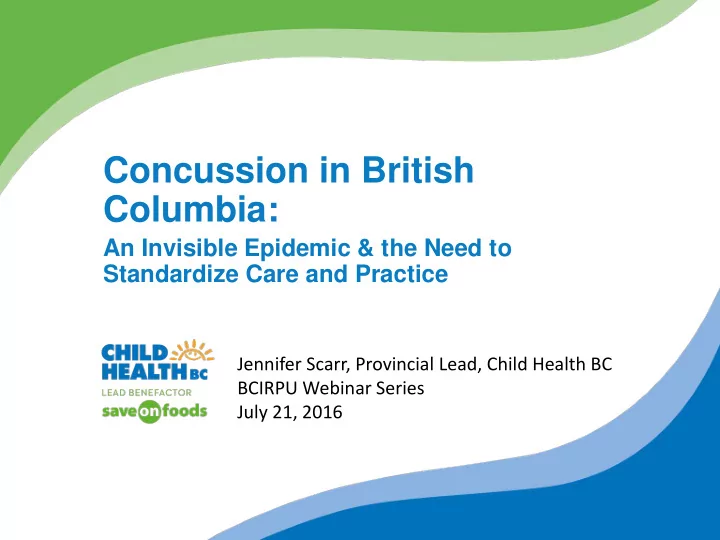

Concussion in British Columbia: An Invisible Epidemic & the Need to Standardize Care and Practice Jennifer Scarr, Provincial Lead, Child Health BC BCIRPU Webinar Series July 21, 2016
Objectives of the Presentation • What is the burden of concussion on BC children and youth? • Where do BC children and youth receive healthcare services? • How can we ensure that BC children and youth receive evidence based concussion care?
1 What is the burden of concussion on BC children and youth? 3
How a concussion is handled in the minutes, hours and days after injury can SIGNIFICANTLY influence the extent of damage and recovery from this injury
Signs of Concussion
Concussion – Burden in BC • 16,888 concussions seen in emergency departments throughout the BC Lower Mainland for all ages: – 6,651 from VCH (2011) – 8,959 from FH (2011/12) – 1,278 presenting to BCCH (2009) • 39.5% of the total - children and youth ages 0-19 years • 59.4% of the total – males • 9,027 children & youth ages 0-19 years presented to BCCH with a concussion / minor head injury during the 2001-2009 period.
Health Authority Summary
2 Where do BC children and youth receive healthcare services? 3
★
Source: http://www.bcrobyn.com/2012/12/how-big-is-british-columbia /
3 How many hospitals in BC provide concussion services to children and youth 3
4 How can we ensure that BC children and youth receive evidence based concussion care? 3
Developing a Provincial Approach • Provincial meeting – stakeholders from across the province • Tiers of Service Framework – used to support planning • Pediatric Concussion Guidelines – ONF work completed; used to support planning • CATT – tool and resource to support communication of evidence based recognition, care and management • Provincial Data
Why the need for tiers of service? • Provides a common language to streamline planning, coordination & integration of services across geographic boundaries & sectors • Facilitates a common understanding of the responsibilities & relative capabilities of each type & level of service • Supports the availability of appropriate resources for services to fulfill those responsibilities
Tiers at a Glance Refer to handout 30
Tiers of Service & Concussion
Tier 1 & 2
Concussion Awareness Training Tool • Evidence-based Resource which includes: – Training (e.g. MainPro M2 Credits for CATT HP) – Quick and easy access to guidelines/information – Resources (clinical, patient, journal articles, parent handouts, etc.) – Links to other credible web-based resources – Printable resources for individuals (e.g. patient information, parent resources, smartphone accessible resources, etc.) – FAQs
CATT – Medical Professionals
Return to Play
Return to Learn
Provincial Tier 1 & Tier 2 Work • Embedded in ED electronic discharge information • Presentations to Divisions of Family Practice • Influencing sports organization policies (eg. BC Minor Hockey, Football BC) • Working with school superintendents and staff to support Return to Learn • Community displays; newspaper articles; sporting events • Evaluation
CATT – Evaluation • Qualitative: target audience feedback in iterative tool development • Quantitative: research evaluation completed on toolkit – awareness, knowledge and skills increased • Quantitative: ongoing website analytics
CATT – Future Work • Updating the Healthcare Provider section • Enhancing the Mental health information • Translation of resource into other languages • Supplemental materials - mood changes, sleep hygiene, headaches
Tier 3 & 4
Provincial Tier 3 & Tier 4 Work • Provincial Workshop – sharing results • Health Authority specific data reports – used to support regional planning • Complete jurisdictional review of pediatric concussion programs • Articulate the requirements of a Tier 4 clinical service for pediatric concussion • Provincial leadership and quality
Objectives of the Presentation • What is the burden of concussion on BC children and youth? • Where do BC children and youth receive healthcare services? • How can we ensure that BC children and youth receive evidence based concussion care?
Questions
Thank You
Recommend
More recommend